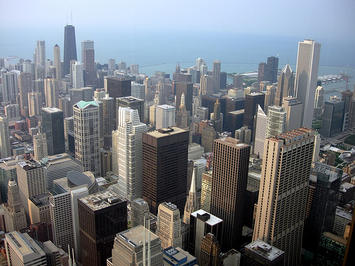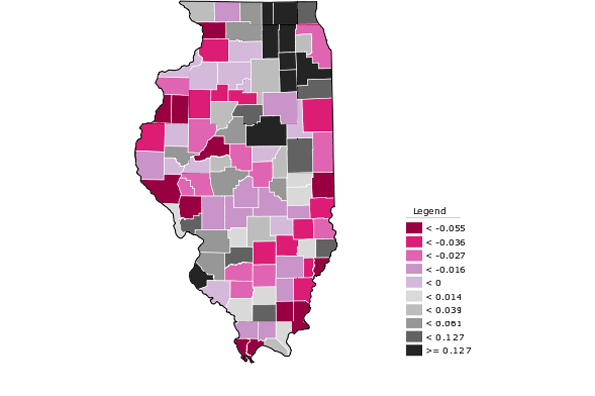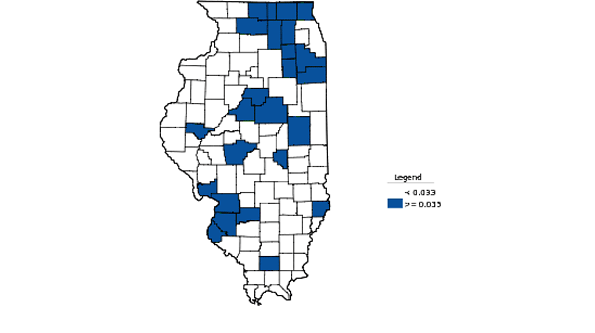
The Census results are out for Illinois, and it's bad news for the city of Chicago, whose population plunged by over 200,000 people to 2,695,598, its lowest population since before 1920. This fell far short of what would have been predicted given the 2009 estimate of 2,851,268. It's a huge negative surprise of over 150,000, though perhaps one that should have been anticipated given the unexpectedly weak numbers for the state as a whole that were released in December.
The American Community Survey data from last year show a clear improvement in items like college degree attainment (up 7.6 percentage points since the 2000 Census) and median household income (up 18%, which trailed the nation slightly, but beat Cook County and the state). These data points show the very real improvements that have swept over a portion of the city, the visible gentrification that envelops the greater core area has now been shown to have been unable to power overall population growth, or to restrain the rampant exurbanization in the region.
White and Black Flight
The non-Hispanic White Only population of the city actually declined by 52,449, or 5.78%. The “minority” population declined even further, -147,969 or 7.44%, meaning the city actually grew its white population share by 0.38 percentage points, perhaps indicating the early stages of the “Europeanization” of Chicago as the core gentrifies and disadvantaged groups and the white working class are pushed further to the fringe.
Indeed, the Black Only population plunged by 177,401 as blacks increasingly moved to suburbs, especially southern ones like Matteson, Lansing, Calumet City, Park Forest, and Richton Park, each of which added thousands of new black residents. Some indications are that a significant number of black residents left the region altogether. The traditional black magnet of Atlanta – which struggled through much of the decade – was a top five destination for people leaving Chicagoland over the past decade, and Chicago was the #2 source of in-migrants to Memphis, another black hub, according to IRS data.
Hispanic population was the bright spot for Chicago, as the city added Hispanic residents to the tune of 25,218, or 3.35%. Hispanics boosted their population share in the city by nearly 3 percentage points. But even this growth isn't that impressive. The city of Indianapolis, at less than a third Chicago's population, added over 45,000 Hispanics on a much smaller base.
Demographic Reality: Massive Exurbanization
Much has been made of Chicago's legitimate and real urban core renaissance, but the cold reality remains that this is one of America's most sprawling regions. Regional growth continued to be heavily focused not in the city or established inner suburbs, but the exurbs. Kendall County more than doubled in population, and counties like Grundy, Boone, and Kane also made the top five in the state. Cook County, which is about half made up of the city of Chicago, as a whole actually lost population. And traditional suburban powerhouse DuPage has flattened, while Lake County, Illinois fell just short of the national average in growth. During the last decade, a net of over 25,000 people moved from metro Chicago to metro Rockford, making that city the #2 destination for those leaving Chicagoland. Given that Rockford is hardly an economic mecca, clearly exurbanization is spreading far beyond traditional metro boundaries. Sprawl of the most intense kind is alive and well in Chicagoland.
The following map illustrates this, with a five bucket sort of 2000-2010 population percentage change, growing counties in black, shrinking in red:

The raw data on regional growth speaks for itself:
|
Core+Suburb vs. Exurb |
2000 |
2010 |
Total Change |
Pct Change |
|
Core + Established Suburb (Cook, DuPage, Lake Counties) |
6,925,258 |
6,815,061 |
-110,197 |
-1.6% |
|
Exurb (Other IL Metro Chicago Counties) |
1,347,510 |
1,771,548 |
424,038 |
31.5% |
This sprawl might be more understandable in rapidly growing cities like Atlanta and Houston that can both densify the core and grow outwards simultaneously. But the Chicago-Joliet-Naperville-IL Metropolitan Division (the full MSA is not yet available since Wisconsin hasn't been released yet) grew at less than half the national average. This means that the exurbanization trend in Chicagoland is almost entirely loss of population share by the core to the fringe.
To put an even starker view on the concentration of growth in Illinois as a whole, this map highlights only those counties that grew faster than the already anemic statewide average:

Other than a handful of counties, the group of fastest growing counties in the state is dominated by suburban and especially exurban Chicago and St. Louis counties.
For those of us who've chosen to plant our flag in the city, these results are most unwelcome news, no two ways about it. This is especially true as underfunded pensions and city budget gaps loom large, and where the per capita load only goes up as the population goes down. This report should be a call to arms to the next mayor and the city as a whole to make the promise of revitalization a reality, and bring growth and prosperity to the city as a whole, not just a the upscale core. Cities like Chicago have to become more aspirational; places of upward mobility to broad sections of the middle and working classes. The city and Cook County can't afford another decade like this one.
Aaron M. Renn is an independent writer on urban affairs based in the Midwest. His writings appear at The Urbanophile.
Photo by Gravitywave












